[Economic Significance] Homoptera includes cicadas, foamhoppers, leafhoppers, treehoppers, waxhoppers, planthoppers, psyllids, whiteflies, aphids and scale insects. It is a larger group in the Insecta class with large morphological changes. , with piercing and sucking mouthparts, and the texture of the forewings is the same (corresponding to Hemiptera), so it is called Homoptera. All feed on plant sap, and many of them can spread plant virus diseases and are important agricultural pests; some species can secrete wax and glue, or form galls and produce gallnuts, and are important industrial resource insects. The chirping of cicadas is melodious, and the wax cicadas and treehoppers have unique shapes. They are ornamental insects that people love to see.
[Identification points] Small to large. The piercing-sucking mouthparts emerge from the ventral surface of the head, and the beak has 1-3 segments, mostly 3 segments. The antennae are short, bristly, linear or bead-shaped. The forewings are uniform in texture, membranous or leathery, and are often placed in a roof-like shape when resting. Some aphids and female scale insects are wingless, and the hind wings of male scale insects degenerate into balance sticks. Females often have well-developed ovipositors.
[Types and Distribution] There are more than 45,000 known species in the world, which are widely distributed around the world. More than 3,000 species are known in my country.
The characteristics of this order can be summarized as follows: the forewings are homogeneous and the beak is close to the front legs. Leafhoppers, planthoppers, aphids and scales often harm agriculture, forestry, fruits and vegetables.
[Classification system and introduction to common families] Homoptera is generally divided into 2 suborders, namely Auchenorrhyncha (the beak is inserted behind the head and in front of the base of the forefoot) and Sternorhyncha (the beak is inserted at the back of the head) and Sternorhyncha (the beak is inserted in front of the base of the forefoot). The beak is inserted between the bases of the forefoot). Our country currently uses a classification system of 5 suborders, among which the suborder Cicada is equivalent to the suborder Cephalothorhynchus, and the remaining four suborders are all derived from the suborder Thoracicorhynchus, which are introduced below.
①Cicadomorpha
The beak is inserted in front of the base of the forefoot; the antennae are bristly; the forewings have obvious claws; the tarsus has 3 segments. Lively and good at jumping, they have strong flying ability and many males can pronounce sounds. .
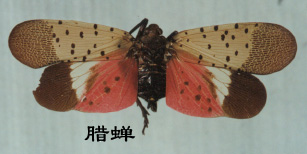
A. Fulgoridae
The antennae are under the compound eyes and have two spherical bases. The forehead often extends forward. There are reticular veins in the hip area of the hind wings. There are more than 700 species known in the undergraduate world, and more than 20 species have been recorded in China. Common ones include spotted wax cicada, longan chicken, etc.
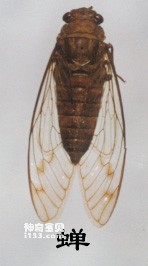
B. Cicadidae
Medium to large, it is the largest group of individuals in Homoptera, with some species exceeding 50 mm in length. The antennae are short and extend from the front of the head. There are three single eyes, arranged in a triangle. The forefoot legs are enlarged and have spines on their lower edges. The peeling of the nymphs is called "cicada sloughing", and the nymphs are parasitized by fungi to form "cicada flowers", both of which can be used in traditional Chinese medicine. There are about 2,000 species known in the undergraduate world, and there are only 200 species in China, such as common grasshoppers and cicadas.

C. Membracidae
Body length 2-20 mm, strange shape, usually black or brown, a few are brightly colored. There are 2 single eyes, located between the compound eyes. The pronotum is very well developed, extending backward to the upper part of the abdomen, often with protrusions of various shapes. There are about 3,000 known species in the world and nearly 300 species in China.

D. Leafhopper family Cicadellidae or Jassidae
Body length 3-15 mm. There are 2 ocelli, and a few species have no ocelli. There is a ridge on the tibia of the hind foot, and there are 3-4 rows of spiny hairs on the ridge. The row of spines on the hind tibia is the most striking identifying feature of the family Phytophthidae. Nearly 20,000 species are known to undergraduate students, and about 1,000 species have been recorded in my country. Insects of this family not only harm crops but also spread plant viral diseases. Common ones include the big green leafhopper and so on.
E. Cercopidae
Body length rarely exceeds 13 mm. The tibia of the hind foot has 1-2 lateral spines and 2 horizontal rows of terminal spines. The base segments of the hind legs are short and tapered. Nymphs usually hide in a mass of foam secreted by themselves to prevent drying and avoid enemies, so they are called bubble blowing bugs or foam bugs. There are one or more nymphs in a ball of foam. After the last molt, the foam cicadas leave the foam and move around lively. The adults do not form foam.

F. Delphacidae
Body length 2-9 mm, mostly grayish white or brown. The front chest is often collar-shaped and the mid-chest is triangular. There are 2 large spines on the tibia of the hind foot, and a movable spur at the end (the difference between the spur and the spur is that the base of the spur is movable at the connection with the body wall). There is a large spur at the end of the tibia of the hind foot, which is the most distinctive identifying feature of this subject. There are 1,500 known species in the undergraduate world, widely distributed around the world, and more than 100 species have been recorded in China. There are many species in this family that are important pests of economic plants. Common ones include brown planthopper, white-backed planthopper, etc.
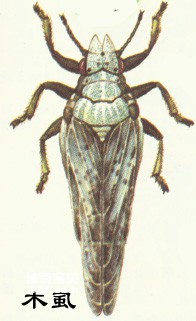
(2) Psyllomorpha
Small, lively and good at jumping. The antennae have 10 segments, are filamentous, with bifurcated ends, and are located in front of the compound eyes. There are 3 single eyes; the beak has 3 segments, arising from the interbasal segments of the forefoot. The tarsus has 2 segments, there are wart-like protrusions at the base of the hind foot, and there are spines at the end of the tibia. Nymphs often have wax glands that can secrete wax protective substances. Some form galls, some produce honeydew, and are often accompanied by ants. Adult nymphs suck plant sap and are agricultural and forestry pests, and some also spread plant virus diseases. This suborder only includes one family, namely Psyllidae. The common ones in China include Chinese pear psyllids, citrus psyllids, etc.
(3) Aphidomorpha
Small polymorphic insects, including wingless and winged types within the same species. The antennae have 3-6 segments and have two different sensory organs, primary and secondary. The tarsus has 2 segments, the first segment is very short. The abdomen often has a ventral tube, and the distal dorsal plate and abdominal plate form the tail piece and tail plate respectively. If there are wings, the forewings are larger than the hind wings and have wing nevus on the forewings.
The reproductive modes of aphids include hermaphroditic reproduction and parthenogenesis, oviparous or ovoviviparous. Aphids suck plant sap, causing plant stunting, excrete honeydew, cause mold growth, and can spread plant virus diseases. They are one of the most important agricultural and forestry pest groups. The gall gallnuts of the aphids are important industrial and medicinal raw materials. There are more than 4,000 known species in the world, classified into 2 general families and 13 families. Here are some common subjects.
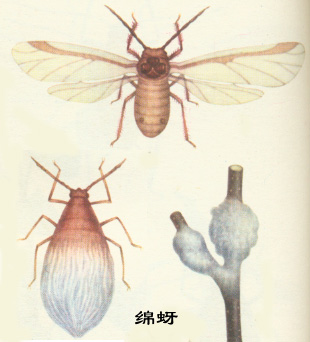
A. Aphididae
The abdominal canal is obvious, and the sensilla on the antennae are round, rarely oval.
B. Pemphigidae
The abdominal canal is not obvious or degenerates into a disc shape. The sensilla on the antennae are ring-shaped or intermittent strips. The gall aphids belong to this family, and 14 species of gall aphids that can form gall aphids are known in my country.
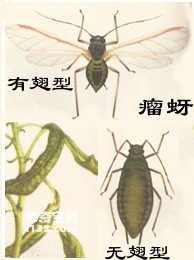
C. Phylloxeridae
No abdominal tube. There is only one sensory circle on the antennae of wingless aphids and young aphids. The antennae of winged aphids have 3 segments. The two forewings have the same veins and the wings are placed flat on the back when resting. Common ones include grape phylloxera, etc.
D. Adelgidae
No abdominal tube. There are two sensory circles on the antennae of wingless aphids and young aphids. The antennae of winged aphids have 5 segments. The two veins of the forewings are separated, and the wings are roof-shaped when resting. Common ones include red pine ball aphid and so on.
(4) Aleyrodomorpha
The tentacles have 7 segments, the 2nd segment is enlarged. Tarsal segments 2, equal in size. Both sexes have wings with white wax powder on them. There are tubular holes on the back of the abdomen of nymphs and adults. It sucks plant sap and is the main pest of woody plants such as citrus and plants cultivated in greenhouses. Common ones include black thorn whitefly, greenhouse whitefly, etc.
(5) Coccomorpha
Generally called scale insects, they have strange shapes and are dimorphic in both sexes. The male has a pair of membrane wings, and the hind wings degenerate into balance sticks. Tarsi 1 segment. The female is wingless, with 1-2 tarsal segments, and the three body segments are often healed. The boundaries between the head and thorax are unclear, and some even the abdomen is unclearly segmented. They are often protected by waxy, gelatinous secretions or special scale shells. It is mostly parasitic on woody plants or perennial herbaceous plants and is an important horticultural and forest pest. Some scale insects secrete wax, glue, and pigments, and have become important industrial and medicinal resource insects. There are more than 5,000 known species in the world, and new species are discovered every year.
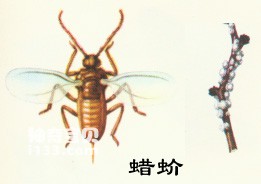
A. Monophlebidae
Mostly large. The male has compound eyes, 10-segmented antennae, and black or anthracite wings. The female antennae have 11 segments, and the thorax and abdomen are clearly segmented. There is a spiracle on the back of the abdomen, and there are no anal rings and stinging hairs. The mouthparts and feet are well developed. The wax filaments are particularly developed. The nymph's antennae have 6 segments and are slightly enlarged at the end. Important pests include cotton scales, paramecium scales, etc.
B. Ortheziidae
The main feature is an ossified anal ring with 6 hairs on the anus. Males have compound eyes and single eyes, 9 antennae segments, and a spiny tumor at the end of the distal segment. The female antennae have 4-9 segments and there is a spiracle on the back of the abdomen. Common ones include nettles, scales, etc.
C. Lacciferidae
The female body is wrapped in a plastic shell with 3 small holes on the shell; the body is slightly oval, with a small head, degenerated antennae, and a tumor shape; the thorax accounts for most of the body; the legs are degenerated; and there are Anal ring and 10 stinging hairs. Male antennae have 10 segments, abdomenThere are 2 long wax threads at the end of the head. The shellac secreted by scale insects is an important moisture-proof coating, smooth coating and adhesive for national defense and civil industry. Shellac wax is a hard natural wax with a wide range of uses. There are 10 species of scale insects reported in my country.
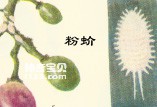
D. Pseudococcidae
Female insects are usually oval, with a few elongated or round. The body wall is usually soft and clearly segmented. There are anal leaves, anal rings and 4-8 anal ring stinging hairs (usually 6) at the end of the abdomen, with well-developed legs and no abdominal spiracles. Free life with wax powder on body surface. Males usually have wings and 4-6 single eyes; there is a pair of long wax threads at the end of the abdomen. Common ones include orange-breasted mealybugs, orange-breasted mealybugs, etc.
E. Coccodae
The segmentation of the female body is not obvious; the antennae have 6-8 segments; the legs are short and small; there is a gluteal cleft at the end of the abdomen, an anus and anal ring stinging hairs, and a pair of triangular anal plates on the anus. Male antennae have 10 segments, 4-10 single eyes, usually 6, and 2 long wax threads at the end of the abdomen. They are widely distributed around the world and are parasitic on trees, shrubs and herbaceous plants. Most species are agricultural, forestry and gardening pests. Common ones in my country include red wax scales, turtle wax scales, etc. The white wax insect is an important wax-producing resource insect unique to my country. It is distributed in the provinces south of the Qinling Mountains. Its host plants are ash trees and ligustrum lucidum.

F. Diaspididae
The female is covered by a shield-like shell formed by the two moltings of the nymph and its secretions; the head and prothorax are healed; the terminal segments of the abdomen (sections 5-8) often heal into a single bony plate, called the hip plate . The shell of the male scale consists of the first peeling and secretions; the antennae are filamentous, with 10 segments; most are winged; there is no waxy thread at the end of the abdomen. There are more than 2,000 known species in the world, widely distributed around the world, with a wide range of host plants. They are common pests on fruit trees, forest trees, and ornamental plants. In particular, citrus has the largest number of pests in the family Platypodidae. Common ones include the sagittal shield scale, the pear branch shield scale, etc.
animal tags: Insects Homoptera cicadas planthoppers psyllids mealybugs aphids
We created this article in conjunction with AI technology, then made sure it was fact-checked and edited by a Animals Top editor.